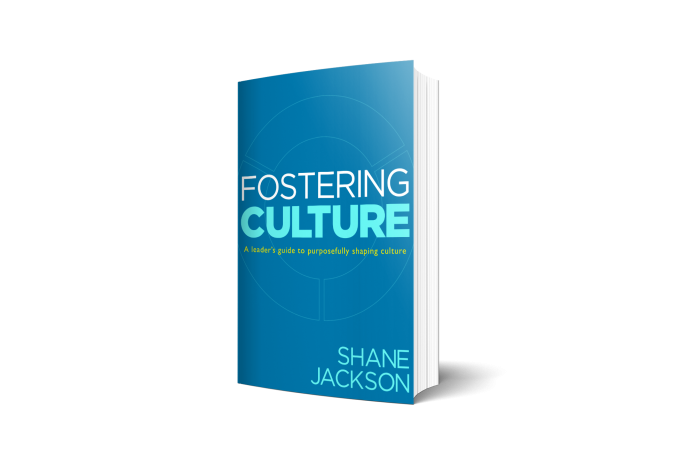
When we think about training as a corporate function, we have to remember we will never be able to train for every situation or circumstance. Our goal should be to equip people with the principles that should be applied and help them develop the skills to apply those principles in unique ways.
At Jackson Healthcare, our values-led culture and the opportunity to live out our core values—Others First (putting others before self), Wisdom (doing the wise thing), and Growth (keep getting better)—are always top of mind and provide a high level paradigm for decisions at every level. My book, “Fostering Culture: A Leader’s Guide to Purposefully Shaping Culture,” includes an idea you might consider as you endeavor to infuse your own culture throughout your organization: Principles are sacrosanct, but methods are not. Here is an excerpt from Chapter 36 of the book:
Our core values and beliefs are really important to us and largely inviolable. However, the way we apply them is not the same by team, by leader, or even at different points in time.
Markets are changing at an unprecedented pace. New and different kinds of competitors appear constantly in every industry. The way customers expect to engage with companies is continually evolving. The solutions and practices of yesterday are often the wrong ones for tomorrow.
We have to be careful that we focus on the principles behind the practices we have today and not the practices themselves. If we focus only on how we do things and forget why we’re doing them that way, we lock ourselves into systems that soon will become outdated. Business models, organizational structures, compensation plans—everything constantly must be held up for scrutiny. Those systems were all created in the past, and the assumptions that led to the creation of those systems are instantly outdated. But the principles behind why and how the systems or practices were created almost never change.
I could take any one of the beliefs we hold dear at our company and point to a business practice we have that is a direct result. I also could show you how that belief was applied differently in different periods of our company’s growth.
There are a tremendous number of judgments leaders and managers must make. We are put into situations daily where we must plot a course where there is no obvious or easy answer. Discernment is an incredibly valuable quality for a leader.
Perhaps the most difficult decisions a leader must make involve change. What should be consistent and what can have variation? What things in our businesses are so core that they should always be the same, and what are the things that should evolve as the world changes?
In our business, almost none of our business practices or systems are unalterable. We want to constantly challenge what we do and reevaluate if there is a better way. This is an incredibly tough concept for most people to believe.
As a leader, one of the hardest judgments to make is when to let someone you are leading make a choice you wouldn’t make. It’s not a wrong choice, and you couldn’t really label it as a mistake, it’s just a different way of doing things.
I recall a situation where a manager uses quarterly objectives to manage his team. He gets increased responsibility and is charged with supervising a manager who prefers semiannual goals with the team he manages. The first manager has a decision to make as to whether he should force the second one to switch to quarterly instead of semiannual goals.
Certainly, there are many factors that go into this equation (such as if there are standards used throughout the company), but the question remains: Is the belief in quarterly goals important enough to insist upon change?
This may seem like a rather trivial issue, but these types of decisions come up routinely and, in sum, can become big deals. Should I force my team to use the same kind of time management system? Should I insist they enter information into the database the same way? Do I give my salespeople leeway on using different sales presentations, or should they all use the same one? Where do you allow for personal style and where don’t you?
In these types of scenarios, I have tried to apply the maxim that principles are sacrosanct, methods are not. In other words, there are some principles we won’t break, but the way we apply those principles can vary.
You have to allow for style in the way leaders run their teams and relate to their people. So when I am faced with a leader who wants to do something differently from the way I would do it or different from existing company practice, I first consider whether the action will accomplish what we want to accomplish in a way that is consistent with our values and beliefs. If it will, and I don’t think allowing the inconsistency of practice with other teams will cause a problem, then I’ll allow it.
It is so easy to get locked into the business models and practices of today. Maintaining the status quo is the easiest path, while forcing or embracing change creates friction that requires more energy to overcome. But business models change—sometimes quickly. We must be wise in judging what should change and what should not.
Is your training program and leadership approach flexible enough to allow for navigation within a set of guardrails, or do you advocate for consistency above all else? If you favor consistency, what opportunities might you be missing for innovative thinking or evolutionary change? The concept of discernment can be both an interesting and powerful trait in your leaders today and tomorrow.
Excerpt from Chapter 36 of “Fostering Culture: A Leader’s Guide to Purposefully Shaping Culture” by Shane Jackson.
Shane Jackson is president of Jackson Healthcare, a billion-dollar, privately held family of healthcare staffing, executive search, and technology companies powered by 1,500 associates. He is also a primary guiding force for Jackson Healthcare’s mission of improving the delivery of patient care and the lives of everyone it touches. Jackson is a speaker on the conference circuit, frequently writes on the topic of intentionally nurturing a values-based culture, and the author of “Fostering Culture: A Leader’s Guide to Purposefully Shaping Culture,” which chronicles his philosophy on workplace culture.




